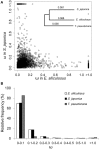Identification of Genes under Positive Selection Reveals Differences in Evolutionary Adaptation between Brown-Algal Species
- PMID: 28861104
- PMCID: PMC5559719
- DOI: 10.3389/fpls.2017.01429
Identification of Genes under Positive Selection Reveals Differences in Evolutionary Adaptation between Brown-Algal Species
Abstract
Brown algae are an important taxonomic group in coastal ecosystems. The model brown algal species Ectocarpus siliculosus and Saccharina japonica are closely related lineages. Despite their close phylogenetic relationship, they vary greatly in morphology and physiology. To obtain further insights into the evolutionary forces driving divergence in brown algae, we analyzed 3,909 orthologs from both species to identify Genes Under Positive Selection (GUPS). About 12% of the orthologs in each species were considered to be under positive selection. Many GUPS are involved in membrane transport, regulation of homeostasis, and sexual reproduction in the small sporophyte of E. siliculosus, which is known to have a complex life cycle and to occupy a wide range of habitats. Genes involved in photosynthesis and cell division dominated the group of GUPS in the large kelp of S. japonica, which might explain why this alga has evolved the ability to grow very rapidly and to form some of the largest sporophytes. A significant number of molecular chaperones (e.g., heat-shock proteins) involved in stress responses were identified to be under positive selection in both species, potentially indicating their important roles for macroalgae to cope with the relatively variable environment of coastal ecosystems. Moreover, analysis of previously published microarray data of E. siliculosus showed that many GUPS in E. siliculosus were responsive to stress conditions, such as oxidative and hyposaline stress, whereas our RNA-seq data of S. japonica showed that GUPS in this species were most highly expressed in large sporophytes, which supports the suggestion that selection largely acts on different sets of genes in both marcoalgal species, potentially reflecting their adaptation to different ecological niches.
Keywords: Ectocarpus siliculosus; Saccharina japonica; adaptive evolution; brown algae; positive selection.
Figures





Similar articles
-
Evolution and Expansion of the Prokaryote-Like Lipoxygenase Family in the Brown Alga Saccharina japonica.Front Plant Sci. 2017 Nov 28;8:2018. doi: 10.3389/fpls.2017.02018. eCollection 2017. Front Plant Sci. 2017. PMID: 29234336 Free PMC article.
-
Transcriptomic and metabolomic analysis of copper stress acclimation in Ectocarpus siliculosus highlights signaling and tolerance mechanisms in brown algae.BMC Plant Biol. 2014 May 1;14:116. doi: 10.1186/1471-2229-14-116. BMC Plant Biol. 2014. PMID: 24885189 Free PMC article.
-
Global expression analysis of the brown alga Ectocarpus siliculosus (Phaeophyceae) reveals large-scale reprogramming of the transcriptome in response to abiotic stress.Genome Biol. 2009;10(6):R66. doi: 10.1186/gb-2009-10-6-r66. Epub 2009 Jun 16. Genome Biol. 2009. PMID: 19531237 Free PMC article.
-
Development and physiology of the brown alga Ectocarpus siliculosus: two centuries of research.New Phytol. 2008;177(2):319-332. doi: 10.1111/j.1469-8137.2007.02304.x. New Phytol. 2008. PMID: 18181960 Review.
-
Ectocarpus: an evo-devo model for the brown algae.Evodevo. 2020 Aug 31;11:19. doi: 10.1186/s13227-020-00164-9. eCollection 2020. Evodevo. 2020. PMID: 32874530 Free PMC article. Review.
Cited by
-
Diversity and evolution of cytochromes P450 in stramenopiles.Planta. 2019 Mar;249(3):647-661. doi: 10.1007/s00425-018-3028-1. Epub 2018 Oct 19. Planta. 2019. PMID: 30341489
-
Transcriptomic analysis reveals insights into deep-sea adaptations of the dominant species, Shinkaia crosnieri (Crustacea: Decapoda: Anomura), inhabiting both hydrothermal vents and cold seeps.BMC Genomics. 2019 May 18;20(1):388. doi: 10.1186/s12864-019-5753-7. BMC Genomics. 2019. PMID: 31103028 Free PMC article.
-
A microRNA-microRNA crosstalk network inferred from genome-wide single nucleotide polymorphism variants in natural populations of Arabidopsis thaliana.Front Plant Sci. 2022 Aug 26;13:958520. doi: 10.3389/fpls.2022.958520. eCollection 2022. Front Plant Sci. 2022. PMID: 36131801 Free PMC article.
-
Integrative analysis of chloroplast DNA methylation in a marine alga-Saccharina japonica.Plant Mol Biol. 2021 Apr;105(6):611-623. doi: 10.1007/s11103-020-01113-9. Epub 2021 Feb 2. Plant Mol Biol. 2021. PMID: 33528753
-
Genome-wide analysis of the Saccharina japonica sulfotransferase genes and their transcriptional profiles during whole developmental periods and under abiotic stresses.BMC Plant Biol. 2020 Jun 11;20(1):271. doi: 10.1186/s12870-020-02422-3. BMC Plant Biol. 2020. PMID: 32527219 Free PMC article.
References
LinkOut - more resources
Full Text Sources
Other Literature Sources

